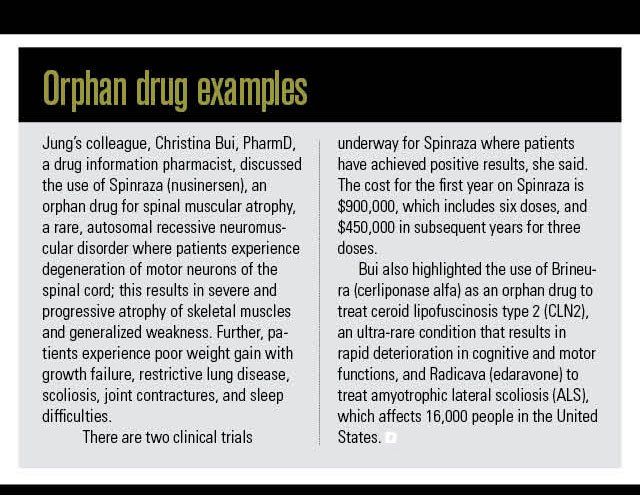How Payers are Responding to Growing Orphan Drug Costs
Click to enlarge

Payers are stepping up efforts to manage the cost and utilization of orphan drug treatments.
That’s according to Steven Jung, PharmD, BCPS, drug information pharmacist at San Diego’s MedImpact Healthcare Systems, who discussed the topic at the Academy of Managed Care Pharmacy Managed Care and Specialty Pharmacy (AMCP) Annual Meeting, in Boston April 25.
What is an orphan drug?
The FDA’s orphan drug designation program provides orphan status to drugs and biologicals that are defined as appropriate for the treatment, diagnosis, or prevention of rare diseases and disorders that fit the following criteria:
- Affecting fewer than 200,000 people in the United States
- Affecting more 200,000 people but aren’t expected to recoup the costs of developing and marketing the treatments
Organizations that sponsor the development of orphan drugs can take part in incentive programs, such as tax credits for clinical trial costs, relief from prescription drug user fees, and marketing exclusivity eligibility upon FDA approval.
Jung pointed out the growth in orphan drug approvals by the FDA has increased from fewer than 30 in 2013 to 70 in 2017.
Because of a backlog in reviewing orphan drug applications, the federal agency launched the “90 in 90 Plan,” which means it will respond to all requests within 90 days, while maintaining consistent, scientifically rigorous review of such applications.
In addition, Jung said the FDA issued draft guidance to the pharmaceutical industry in December 2017 that it would no longer grant orphan drug status to pediatric subpopulations if the following conditions weren’t met:
- The disease in the pediatric population is a valid orphan subset and the drug meets all other criteria for orphan designation.
- The disease in the pediatric subpopulation is a different disease from the disease in the adult population.
How payers are responding to growing costs
Payer sensitivity to the cost of orphan drugs continues to rise, according to Jung. That’s because these treatments can cost hundreds of thousands of dollars each year per patient. In addition, new treatments and indications are being approved by the FDA, and there are few, or in some cases, no available treatment alternatives.
In response, payers have undertaken benefit design changes to manage both utilization and the cost associated with these treatments, he said. These changes include:
- Formulary restriction and specialty tiers
- Shifting from copayments to co-insurance
- Prior authorization
Presenting the results of his analysis of reimbursement data, Jung also noted that payers put more coverage restrictions-the most utilized method was prior authorization-on orphan drugs than they do for non-orphan drugs.
Prior authorization criteria typically include the following:
- Documentation of clinical diagnosis
- Appropriate age
- Prescriber specialty
- Baseline data, such as genetic screening and laboratory values
- Renewal criteria, such as documentation of response
- Quantity limit, such as appropriate dosing
Orphan drug examples
Jung’s colleague, Christina Bui, PharmD, a drug information pharmacist, discussed the use of Spinraza (nusinersen), an orphan drug for spinal muscular atrophy, a rare, autosomal recessive neuromuscular disorder where patients experience degeneration of motor neurons of the spinal cord; this results in severe and progressive atrophy of skeletal muscles and generalized weakness. Further, patients experience poor weight gain with growth failure, restrictive lung disease, scoliosis, joint contractures, and sleep difficulties. There are currently two clinical trials underway for Spinraza where patients have achieved positive results, she said. The cost for the first year on Spinraza is $900,000, which includes six doses, and $450,000 in subsequent years for three doses.
Bui also highlighted the use of Brineura (cerliponase alfa) as an orphan drug to treat ceroid lipofuscinosis type 2 (CLN2), an ultra-rare condition that results in rapid deterioration in cognitive and motor functions, and Radicava (edaravone) to treat amyotrophic lateral scoliosis (ALS), which affects 16,000 people in the United States.

David Calabrese of OptumRx Talks New Role, Market Insulin Prices and Other Topics 'On His Mind'
April 13th 2023In this month’s episode of the "What's On Your Mind podcast," Peter Wehrwein, managing editor of MHE connects with the now Chief Clinical Officer of OptumRx Integrated Pharmacies, David Calabrese. In this conversation, David touches on his transition in January as OptumRx’s former chief pharmacy officer and market president of health plans and PBMs to his new role as Chief Clinical Officer where he now focuses more on things such as specialty pharmacy to home delivery — with an overall goal of creating whole-patient care. Throughout the conversation, Calabrese also touched on the market’s hot topic of insulin prices and behavioral health services within the OptumRx community, among other topics.
Listen
David Calabrese of OptumRx Talks Top Three Drugs in Pipeline, Industry Trends in Q2
July 1st 2020In this week's episode of Tuning Into The C-Suite podcast, MHE's Briana Contreras chatted with David Calabrese, R.Ph, MHP, who is senior vice president and chief pharmacy officer of pharmacy care services company, OptumRx. David is also a member of Managed Healthcare Executives’ Editorial Advisory Board. During the discussion, he shared the OptumRx Quarter 2 Drug Pipeline Insights Report of 2020. Some of the information shared includes the three notable drugs currently being reviewed or those that have been recently approved by the FDA. Also discussed were any interesting industry trends to watch for.
Listen













